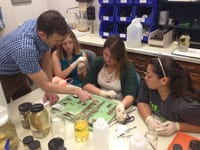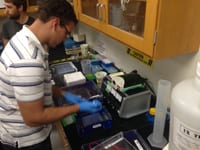An Epic Scientific Exploration
The Florida Museum of Natural History transformed into a beacon of scientific exploration for fifteen students, from April 17 to 19th, made possible through FSU’s Institute for Digital Information and Scientific Communication award funded by a National Science Foundation grant. All fifteen participating undergraduate students, of which six residing at UCF, embarked on a two-day all-expense-paid opportunity to explore the museum while also offered the chance to hear from nearly 25 distinguished scientists.
 This two-day event presented numerous hands-on activities and collection tours for each student. All were able to visit their top three academic disciplines from a pool of seven including: botany, entomology, high performance computing for bioinformatics and computational biology, ichthyology, invertebrate zoology, molecular biology, and ornithology. Opportunities were informative, interesting and memorable, like Andrei Sourakov’s display of butterfly and moth evolution or matching up fish-to-species in ichthyology.
This two-day event presented numerous hands-on activities and collection tours for each student. All were able to visit their top three academic disciplines from a pool of seven including: botany, entomology, high performance computing for bioinformatics and computational biology, ichthyology, invertebrate zoology, molecular biology, and ornithology. Opportunities were informative, interesting and memorable, like Andrei Sourakov’s display of butterfly and moth evolution or matching up fish-to-species in ichthyology.
 During the first day’s molecular biology sessions, many students donned a Sherlock Holmes persona while gloves deep in mock research exercises. It was clear as day many would have rather kept their fedora pinned on while into their research groove than venture off to a new venue of interest!
During the first day’s molecular biology sessions, many students donned a Sherlock Holmes persona while gloves deep in mock research exercises. It was clear as day many would have rather kept their fedora pinned on while into their research groove than venture off to a new venue of interest!
And of course, with Earth Day looming around the corner, museum guides could never allow an opportunity to celebrate pass! Students explored all front-of-house activities, including a tropical excursion through the Butterfly Rainforest, followed by a dance with wolves in the ‘Wolves to Woof’ history of canines exhibit.
The Florida Museum of Natural History and iDigBio not only enabled students to pioneer their own scientific interest, but were highly successful in such an enriching experience for all fifteen Florida undergraduates. Both institutions are in continued contact with all students and remain great supporters as they earn their degree and progress into the future.
For a further in-depth look on this incredible excursion, click to read the original article at: www.iDigBio.org
